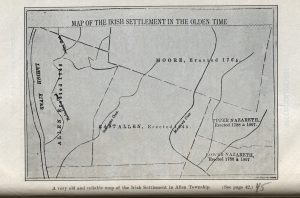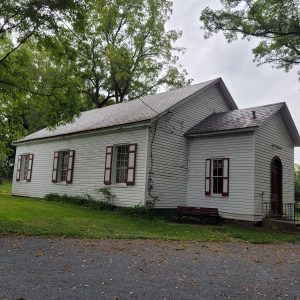The Scotch-Irish settlers of Lehigh Valley
Written by Martha Capwell Fox
The first European settlers in the Lehigh Valley were Scotch-Irish—though that was not what they called themselves. They began arriving in the late 1720s and settled in two places in what is now Northampton County. Their settlements became known by the names of the earliest families–the Hunter-Martin Settlement in the area between Martin’s Creek and Mount Bethel, and the Craig Settlement, between the Catasauqua and Monocacy Creeks.
Who were they?
Historian James Layburn says the term “Scotch-Irish” is an Americanism—unknown in the British Isles or Ireland—that may have arisen in the 19th century to distinguish the descendants of the Ulster Scots from the millions of Irish Catholics who arrived in the 19th century. (American Heritage December 1970) He writes that the Ulster Scots—though commonly called “Irish” as late as the early 1900s due to their century in Ireland–were the first settlers to identify themselves as “Americans” rather than by the name of their colony or their origin.
Where Did They Come From?
The “Ulster Plantation” was born out of a desperate political attempt by the English rulers of Ireland in the early 1600s to subdue that fractious island while solving their domestic problems with religious dissenters.
The Lowland Scots along the border with England were landless tenant farmers eking out a bare living. Nationalistic fervent Presbyterians, they vehemently opposed both Roman Catholicism and English Anglicanism. In 1610, King James I of England, who was also King James VI of Scotland, decided to lure the Lowlanders and English dissenters to the northern Ireland province of Ulster by giving them fertile farmland seized from rebellious exiled Irish earls. The idea was to quell Catholic Ireland by flooding it with Protestants.
The Ulster Plantation was initially a success. By the early 1700s, Scots heavily outnumbered the Irish and English in Ulster. James Leyburn writes that the Ulster Scots developed self-governing skills in their churches, now independent of the Presbyterian Church of Scotland’s control. (They kept the strict disciplines and morals though.) As landowners they produced flax and wool and developed textile industries.
By the early 1700s, Ulster’s booming textile trade damaged similar industries in England, so Parliament imposed crippling taxes on Irish goods. After a century in Ireland, the farmers were informed that they were 99-year leaseholders, not owners, of their lands, and going forward they would be paying increasing rents. Then devastating droughts and freezes, and animal and human epidemics began in 1710. Worst of all, laws passed by the English Parliament suppressed religious freedom by forbidding any non-Anglican clergy from teaching or performing marriages or funerals.
This triggered the first mass migration of the Ulster Scots to America. In 1718-19, 3000 departed for the colonies. After the earliest migrants found no welcome in Puritan New England and Anglican Virginia, most headed for tolerant Pennsylvania, settling first in Chester and lower Bucks counties. Then the Philadelphia Presbytery, founded in 1717, gave the new arrivals a foundation for carrying their everyday and religious lives out to the Pennsylvania frontier on the Forks of the Delaware.
The Craig Settlement 
Four Craig brothers—William, Daniel, James, and Thomas, with their families and three unmarried sisters—arrived in Philadelphia in the early 1720s. In 1728, James and Thomas, their sister Jane and her husband, John Boyd, and sixteen other families moved to the Lenape lands near Catasauqua Creek, cleared the land and began farming. A few years later, brother Daniel traveled to the north end of the settlement near the Monoquasy (Monocacy) Creek and became the first European settler in the area that became the town of Bath.
The Craigs descended from an ancient line of Saxons and Scots with a long history of carving lives out of the wilderness, living among enemies, and defending unpopular beliefs. They were well-suited to be the first European settlers of the Lehigh Valley.
The Craig Settlement was roughly bounded by the Hokendauqua Creek to the northwest, the Catasauqua Creek to the southwest, and the Monocacy Creek to the east; most of the area is now East Allen Township. Their farms were connected by footpaths (many probably of Lenape origin) and relations between the settlers and Lenape were mostly peaceful.
Problems arose in the 1730s. The settlers were essentially squatters, though they held that they had been invited by authorities to emigrate to Pennsylvania and had made the frontier safer and more developed for later settlers. William Penn’s sons saw the land as theirs to make money with. By 1735, William Allen owned the land, so some settlers purchased their farms from him. Others were given the farms outright at the time, while others gained ownership of leased land when the Allens were convicted as traitors during the Revolution. But others packed up and moved further west, and some all the way to the Shenandoah Valley.

Relations with the Lenape remained generally peaceful despite the Penn brothers’ theft of native lands through the Walking Purchase in 1737 and even during the French and Indian Wars. But on October 8, 1763, Jane Horner was killed by a group of Lenape who apparently feared she would alert the settlement while they were on their way to avenge the violent theft of their trade goods by a known “Indian hater” soldier.
First Church and Cemetery in Northampton County
The Craigs and other settlers—identified as the Reed, Wilson, Armstrong, Gregg, King, Walker, Ralston, Hayes, Lattimore, Kerr, Brown, and Horner families—began meeting for religious services in each other’s homes. In 1731, they constructed a log church, the first house of worship in Northampton County. The first cemetery in Northampton County, located on Rt. 329 near Weaversville, is alongside the third church on the site, built in 1813. Jane Horner and her family are buried there, along with two Lenape friends of hers, a Revolutionary War general, a Presbyterian minister who was killed at the Battle of Trenton in 1777, doctors, lawyers, and twenty-one documented veterans of four wars.























Join the Conversation!